Oak Harbor Marina
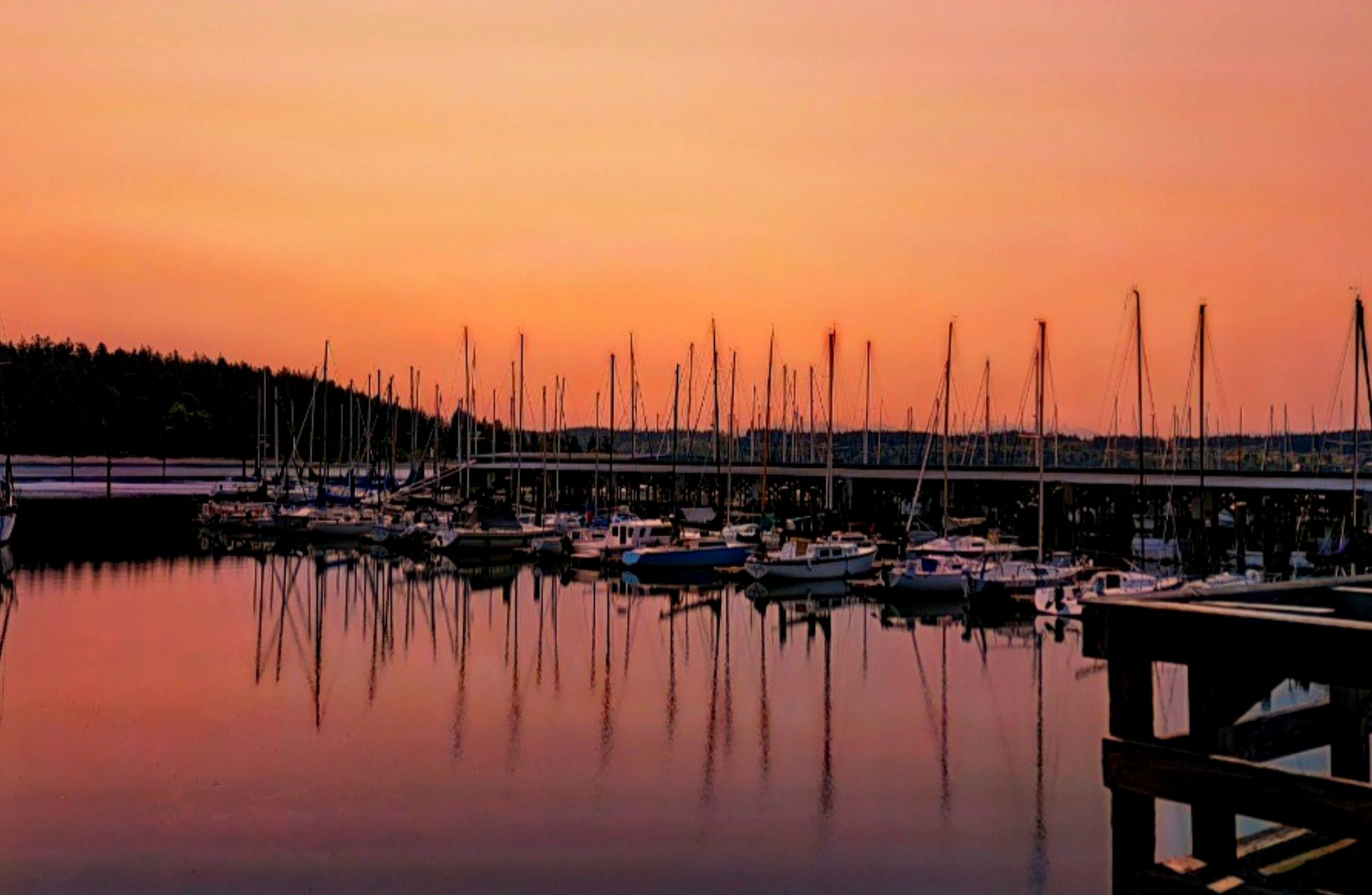
Conveniently located in a northern cove on Whidbey Island sits the Oak Harbor Marina. Its stunning panoramic views of Puget Sound and the Cascade Mountains serve as a gateway to an exceptional nautical lifestyle. Boasting modern facilities and a vibrant community, the marina provides access to various amenities. Charming shops and dining options are within walking distance. Visitors and residents alike can enjoy the convenience of boat launches, fuel docks, and well-appointed guest moorage. The Oak Harbor Marina’s unique location and array of offerings make it a perfect spot to launch from for long trips to the San Juan Islands or Canadian Waters but also for day trips to Penn Cove and the Saratoga Passage.
Learn more about the Oak Harbor Marina here.
If you would like to learn more about Whidbey Connect with us here.
You can also, check out the rest of Whidbey’s beautiful destinations from this series here.
Deception Pass
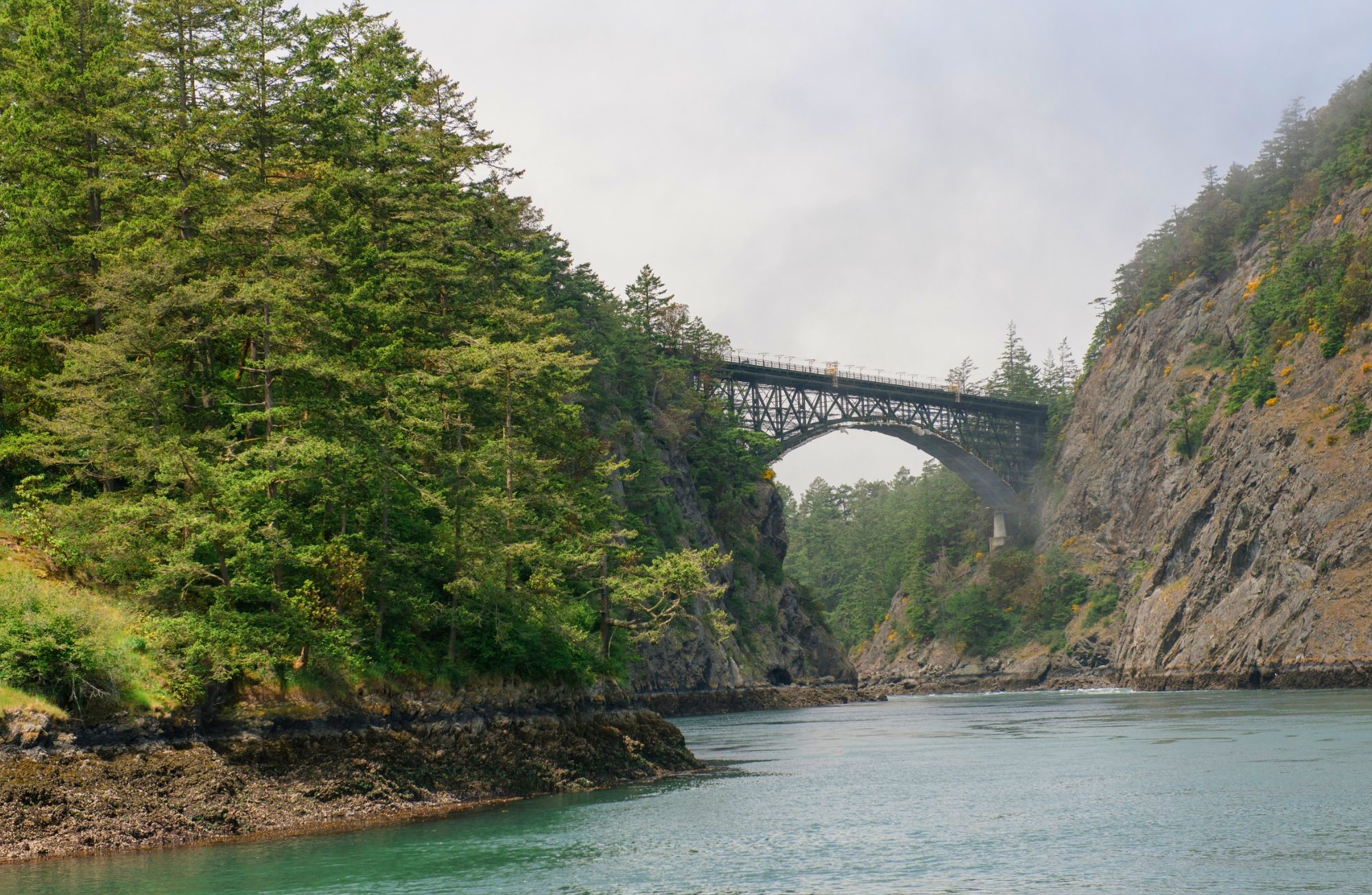
Deception Pass derives its name from its complex and tricky currents that can deceive mariners. It is notorious for its powerful and unpredictable tidal currents that can shift rapidly. Mariners, unfamiliar with the area often found themselves deceived by the challenging conditions. Navigating through the pass required skill and local knowledge to avoid dangerous whirlpools, strong eddies, and turbulent waters. Before European settlers arrived the indigenous tribes relied on the pass as a crucial trade route providing access to prime fishing grounds. Deception Pass holds a place of historical significance, symbolizing the resilient maritime traditions and skills of Native American peoples who thrived in the challenging coastal environment. Their mastery of the pass’s currents & ability to safely navigate its waters contributed to the rich cultural tapestry of the region.
Photo taken by: @KelseyKurtis
Learn more about Deception Pass here.
Check out the rest of Whidbey’s beautiful destinations from this series here.
Why Are There Tsunami Signs on Whidbey Island?
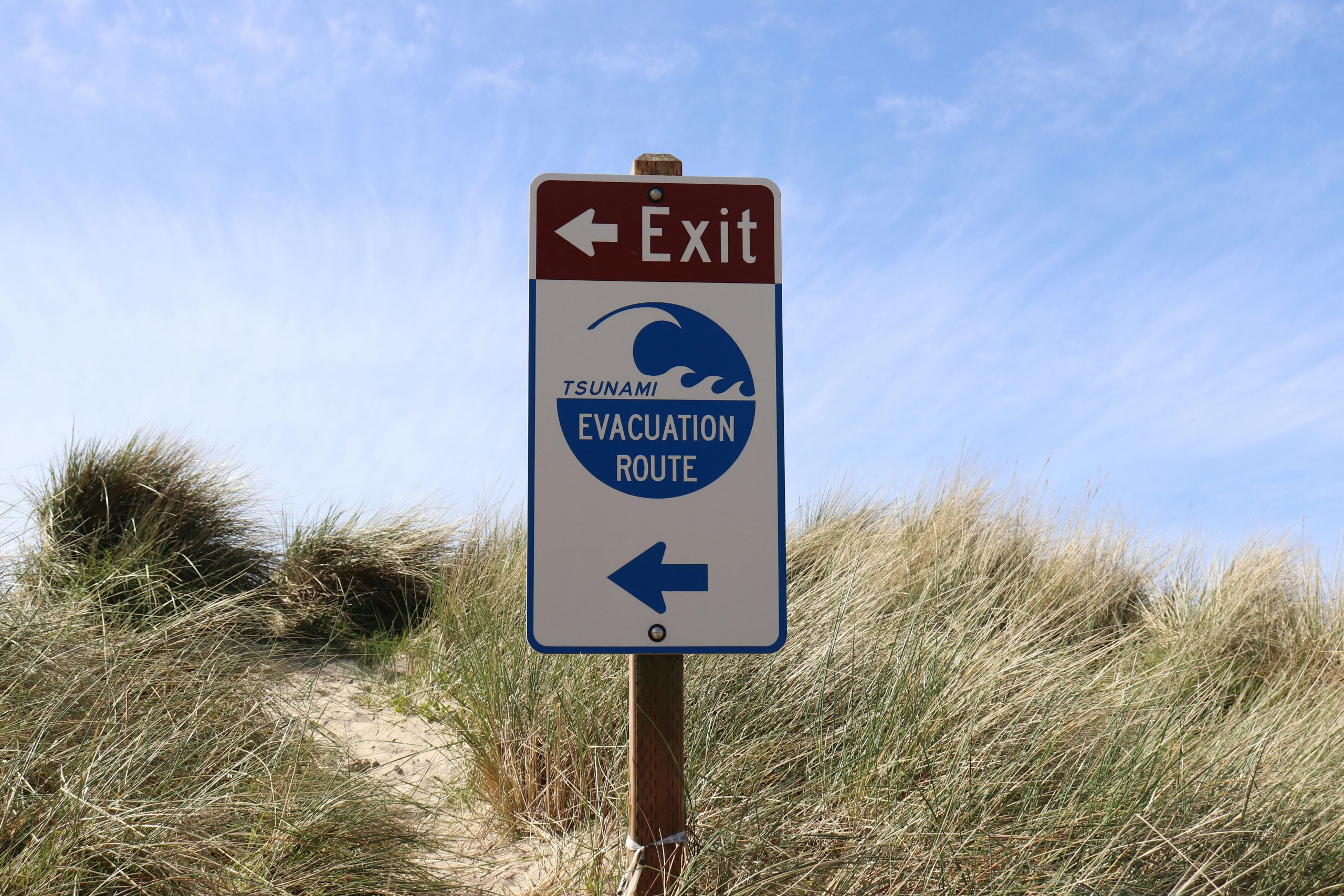
If you have spent any time on Whidbey Island, it is likely that you have noticed the tsunami evacuation signs posted along roads and beaches. These signs may raise questions for newcomers or visitors. Why does an island surrounded by serene waters have tsunami warnings? The answer lies in the region’s unique geography and seismic activity.
The Risk of Tsunamis on Whidbey Island
Whidbey Island is located in part of the geologically active area known as the Cascadia Subduction Zone. Roughly 600-miles of fault line runs from Northern California to British Columbia, where the Juan de Fuca tectonic plate meets the North American tectonic plate. When these plates shift or collide, they can trigger large earthquakes — and in some cases, tsunamis.
Tsunamis are massive ocean waves typically caused by undersea earthquakes or volcanic activity. While Whidbey Island is somewhat sheltered by its location in Puget Sound, a major earthquake along the Cascadia fault or from another undersea event could generate a tsunami that impacts the island’s coastal areas.
Why Are There Evacuation Routes?
The tsunami evacuation signs posted throughout Whidbey Island are part of a broader safety plan to help residents and visitors reach higher ground quickly in the event of a tsunami warning. Coastal towns like Langley, Coupeville, and Oak Harbor have low-lying areas that could be vulnerable to flooding if a tsunami were to occur.
The signs are strategically placed to direct people away from beaches, marinas, and waterfront areas toward safer locations on higher ground. Being aware of these routes and having a plan in case of an emergency is an important part of living in a coastal region. Island County does a great job of providing tsunami information including a high ground map that you can visit by clicking here.
How Likely Is a Tsunami on Whidbey Island?
The likelihood of a large tsunami hitting Whidbey Island is low, but not impossible. Scientists and geologists monitor the Cascadia Subduction Zone closely, and while large earthquakes are rare, they have occurred in the past. The most notable event was the 1700 Cascadia Earthquake, which triggered a tsunami that impacted coastal communities from Washington to Japan. You can read more about what that looked like on January 15, 2022 by clicking here.
While Whidbey Island may not face the same tsunami threats as coastal communities on the open ocean, it is still vulnerable to localized tsunamis caused by underwater landslides, known as “submarine landslides.” These could result from large earthquakes or other geological shifts in Puget Sound.
What Should You Do in the Event of a Tsunami Warning?
In the rare event of a tsunami warning on Whidbey Island, the most important thing to do is move to higher ground immediately. Familiarize yourself with the evacuation routes marked by the tsunami signs, and always follow guidance from local authorities and emergency services.
Here are a few tips to stay safe:
· If you feel strong shaking from an earthquake, don’t wait for an official warning — head to higher ground immediately.
· Know your evacuation routes and have a family emergency plan in place.
· Stay informed by signing up for local emergency alerts and having a battery-powered radio on hand.
Preparedness Brings Peace of Mind
While the thought of a tsunami can be unsettling, it is most important to remember that Whidbey Island’s local authorities and emergency response teams are well-prepared. The presence of tsunami signs and evacuation routes are simply a proactive measure to ensure everyone’s safety.
By staying informed and knowing what to do in an emergency, you can enjoy everything Whidbey Island has to offer with peace of mind. After all, living on this beautiful island means being prepared — and being part of a community that looks out for one another. Connect with us.
The Development of Deception Pass
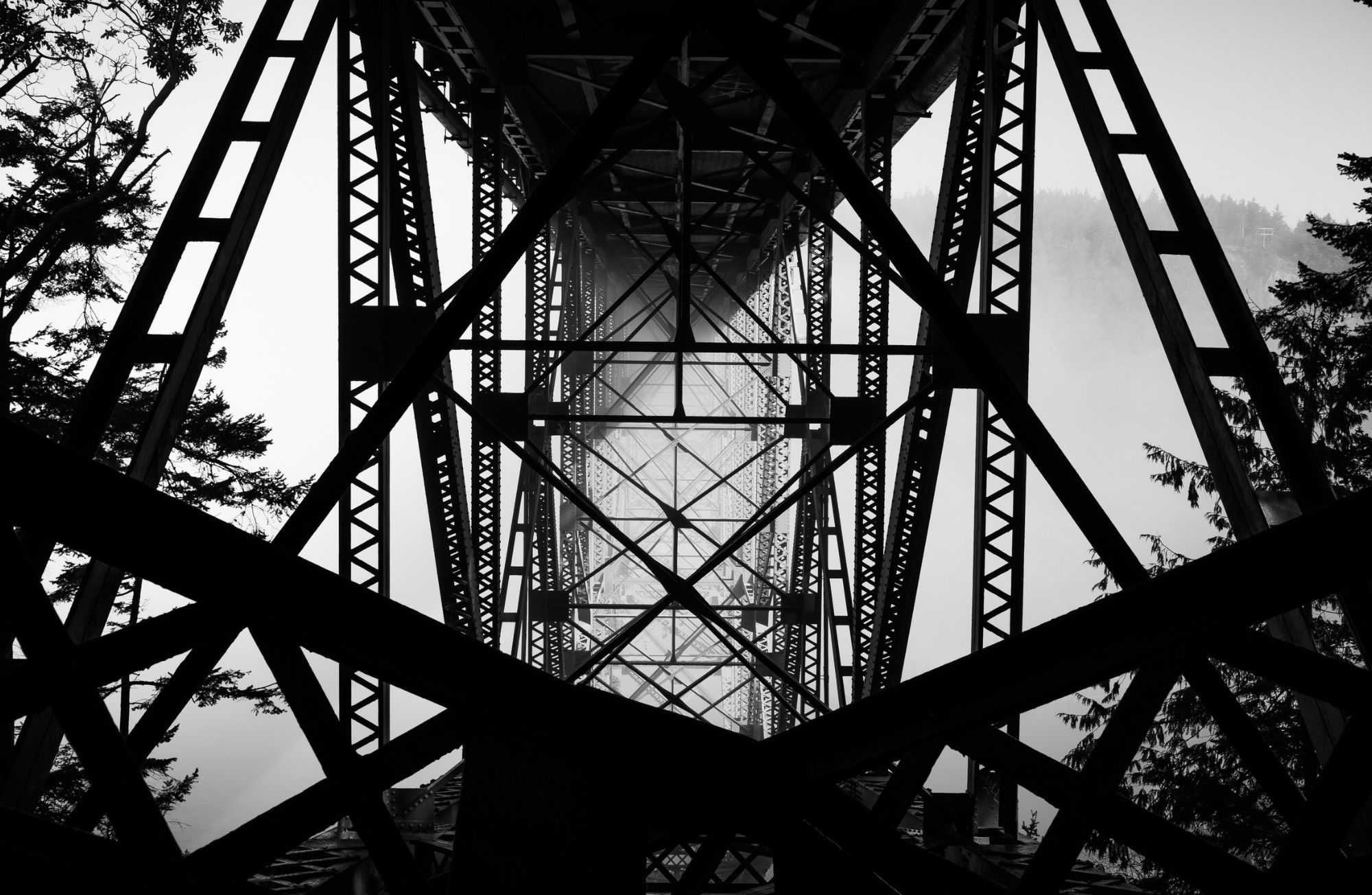
Recognized for its breathtaking beauty and stunning engineering, the Deception Pass Bridge is one of the most iconic landmarks in Washington State. Spanning the turbulent waters of Deception Pass and connecting Whidbey Island to Fidalgo Island. The bridge has become a symbol of the Pacific Northwest’s natural and manmade wonders, drawing countless visitors each year.
Boating Under Deception Pass
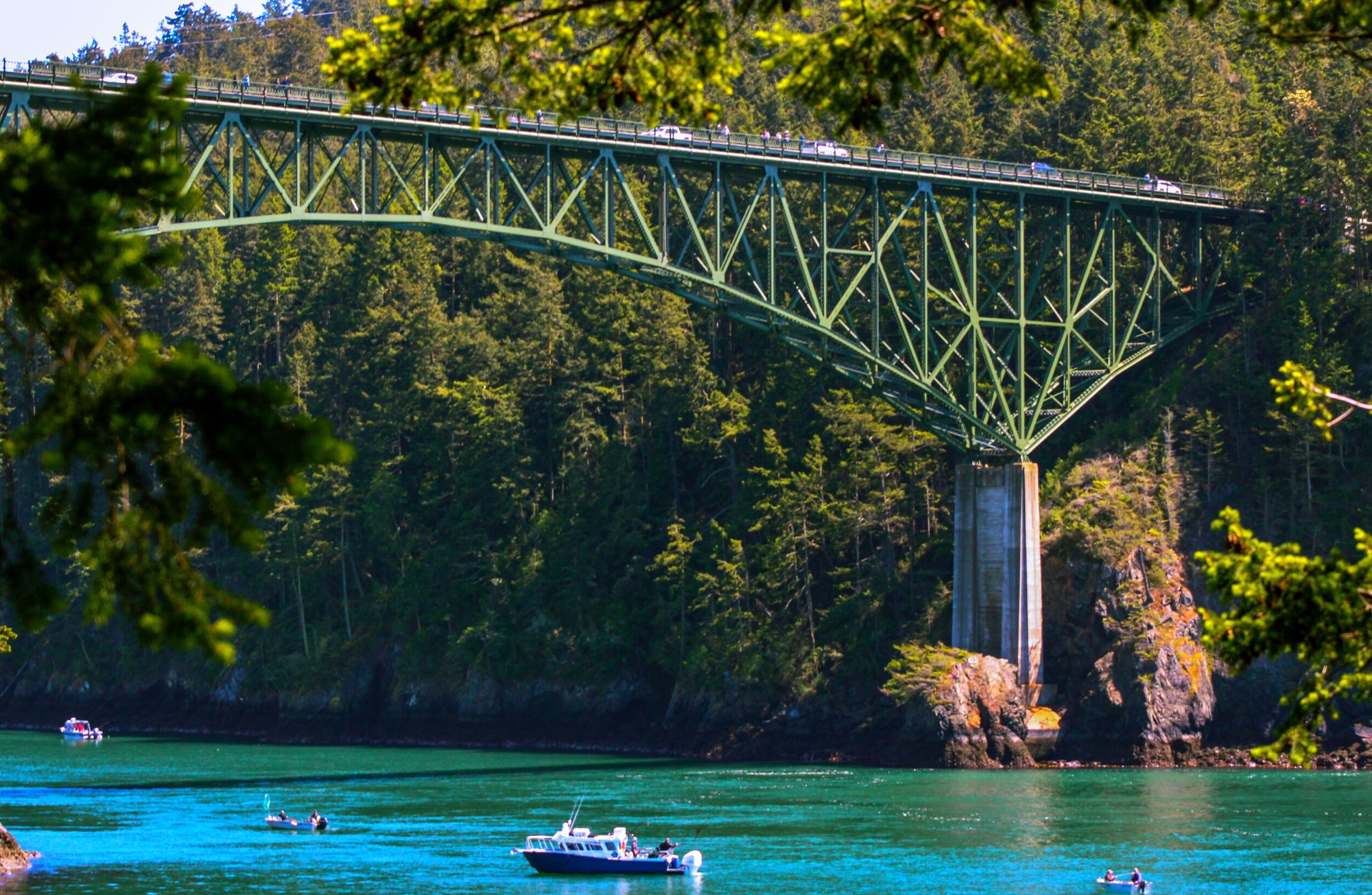
Have you ever thought about boating under Deception Pass? Deception Pass stretches over three islands creating two channels of water. The smaller narrower passage named Canoe Pass tends to be used for those traveling in kayaks as it is roughly only 30 feet in width. While both are framed by high rocky sides the larger of the two passageways has some of the fastest and strongest currents in all of Puget Sound. Boaters beware! 4 times a day waters from the Strait of Juan de Fuca (to the west) and Saratoga Passage (from the east) push more than 127 million pounds of water per second through this 150-foot passageway creating currents that can exceed 9 knots. While it is gorgeous, it is important for boaters to know when and how to travel safely through the pass.
This photograph was taken by Kyle Brown
If you would like to learn more about Whidbey Connect with us here.
You can also, check out the rest of Whidbey’s beautiful destinations from this series here.
Navigate to Deception Pass:
Sunset at Deception Pass State Park
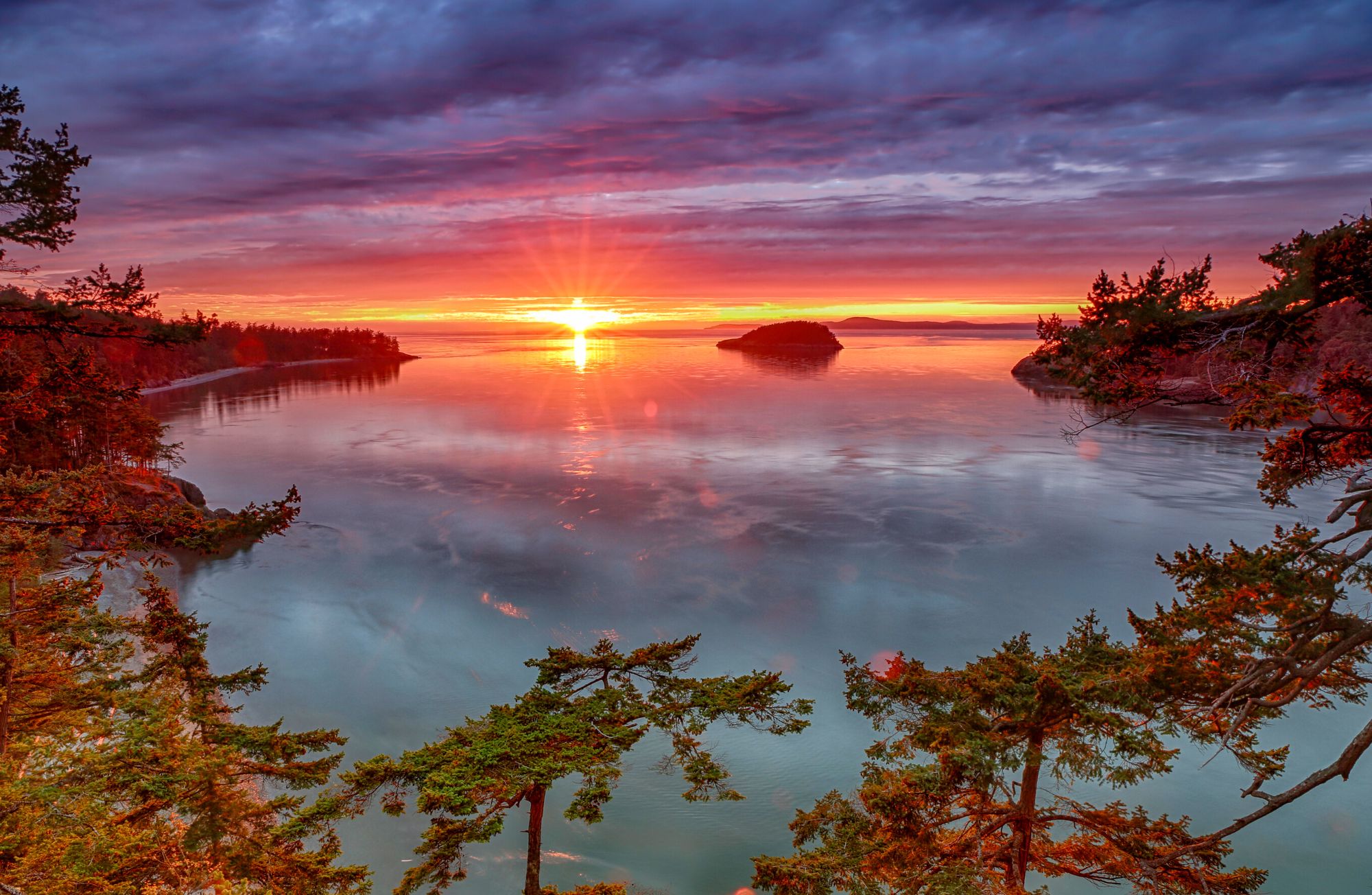
Destination Deception Pass! Have you ever stopped for a sunset at Deception Pass State Park? This image, taken from Pass Island looking out towards Deception Island at sunset, is one of the glorious scenes that keep Deception Pass the #1 most visited park in all of Washington State! There are so many ways to enjoy the scenery of this park. From the courageous and skilled boaters who brave swirling currents and tidal ranges over 12 feet apart to the day-use picnickers who enjoy West Beach tables barely a foot from the trunk of their car and everyone in between. Even in the depths of winter, there is magic in the evergreen forests and iconic PNW views to fuel the outdoor spirit of anyone who visits!
Check out the rest of Whidbey’s beautiful destinations from this series here.
Get directions to Deception Pass here.
A Bit of Island Airplane History

Naval Air Station Whidbey Island (NASWI) was born suddenly. Before World War II, the U.S. Navy knew it needed a base for its patrol planes, one part of the defense of the northwest corner of the 48 states. The attack on Pearl Harbor energized action. Within a few months, construction had begun. Since then, the base has had a history of adaptation and change. Follow along for a bit of island airplane history.
Flat farmlands were turned into airfields
Space was found and made for seaplanes. Land-based and sea-based planes had found homes. In 1943, OutLying Field (OLF) was born from the need for an auxiliary airfield.
Patrols guarded the entry to the area. Naval gun crews trained on the island.
Seaplanes excelled at long, slow cruises over the ocean looking for – anything. There’s a lot of empty ocean to our west, and there weren’t satellites to show us what was out there. Ships helped, but planes could cover more territory. The PBYs could also stay up for a day searching for other planes, ships, subs, and sailors in need of rescue.
The need for change
World War One proved the need for projected air power, a technology that was changing rapidly. Training was a constant requirement. Flying was still a relatively new thing. The Navy needed lots of pilots, and as airplanes changed, the pilots had to change too.
Aircraft carriers were a new thing, too. That meant more training. They’d used the Great Lakes, but that was rather far from the coast.
Carriers carried fighters, smaller airplanes that were fast, rugged, and capable enough for combat, but that also had to take off and land from a floating sheet of metal and wood. Give an airplane a long enough runway, enough power, and eventually, it will probably fly. Carrier planes didn’t and don’t have that luxury. The end of the world was visible from their cockpits. That training took guts, but it was too much to ask for them to practice at sea. Practicing with a runway on land allowed for a margin of error.
Those planes were props, propellor-driven airplanes that were noisy (it was a war) and new. A decade or two earlier, airplanes were more likely to be biplanes made from fabric stretched across wood frames. The original engines were much smaller, too. A new class of pilots had to learn the latest technologies and how to operate in the new environment that was a carrier at sea in a war.
Whidbey before World War II
Before World War II, Island County’s population was about 6,100. That was all of Whidbey Island and Camano Island. That changed. Service members were assigned here. Businesses and families grew. The location couldn’t be ignored.
After World War II
After the war, many stayed or moved back when they could.
The Navy’s needs increased. War remained, including the Cold War. Fliers still needed to be trained, or retrained. Sometimes, the retraining was because the airplanes’ changes were radical: faster, heavier, more capable. Welcome the jets.
Jets
Jets were being developed during the war, but it took years before jets became viable solutions for the Navy. The carriers were bigger, but the takeoff requirements were tougher. Flying from a deck was never easy.
The tight turning maneuverability of prop planes became less important than the speed of jets. And the jets just kept getting faster. It wasn’t until the mid-50s that A-3D jets began to fly in and out of the Navy’s Whidbey Island facilities. The A-6s were introduced in the mid-60s. The EA-18G began to arrive in 2009. Planes could finally go supersonic and could even accelerate while going straight up. Thrust!
Throughout, propeller-driven patrol planes like the P-2 and P-3 operated and remained on watch. It wasn’t until 2012 that the patrols went to jets with the P-8.
Helicopters were added, something that local rescues benefited from.
The missions changed
Dogfighting wasn’t as important as missiles and electronics. Wait a few years, and the missiles were targeting other missiles in enemy missile systems. Electronic cat and mouse is an understatement for the new fight.
And there are undoubtedly new missions civilians won’t know about. That’s the nature of security.
Welcome the drones. They’re harder to notice, on purpose. Their operators have training and operational needs, but they may be less dependent on places like OLF. Vehicle hardware and software upgrades can happen elsewhere. But drones don’t work alone, or at least don’t have to. Operations can involve several kinds of vehicles with several sub-missions. That coordination takes practice, too.
Whidbey grew
Things have grown. In 1940, Island County (Whidbey plus Camano) had about 6,100 residents. Whidbey alone has over 67,000 now, more than eleven times the population of the County back then. Currently there are about 11,000 personnel associated with NASWI, almost twice that original population. They, and our allies’ pilots who also train here, mean the base is busy. Finding room for everyone has become more of an issue. Both people and planes are taking up more space. There are overlaps. There are adjustments.
The U. S. Navy’s presence has been one of responding to needs and requirements for almost a century. What’s next? At this pace of change in the world, guessing what’s next may be like trying to imagine a supersonic jet from the viewpoint of a grassy strip after the war to end all wars.
There’s more to the story. There always is. If you are interested in digging deeper follow these links to fill out how we got here.
- HistoryLink.org – Island County — Thumbnail History
- U.S. Navy – NAS Whidbey Island History
- National Bureau of Economic Research – Census U.S. Decennial County Population Data, 1900-1990
If you are considering a move to Whidbey Island or are getting relocated to NAS Whidbey make a connection with us here, not only to help you find your home but also to learn about life on Whidbey.
Working On Whidbey

Are you thinking of moving to Whidbey and wondering what working on Whidbey looks like? We’re not all retirees. Of Island County’s ~87,700 residents, ~28,000 residents have full-time jobs. (EDC Island County Profile 2020) The Navy accounts for ~11,000, so estimate that total at ~39,000. There are many retirees, children, and people employed part-time or not at all. One answer doesn’t fit all. Keep reading for the details.
The Navy Dominates
The Navy is the largest employer by thousands. If you live in or around Oak Harbor, they are hard not to notice. Some people in the military live as far south as Clinton. Others are quite far off-island and commute 45 minutes or more. Take a look at a map and notice the roads heading to the big blank space just north of Oak Harbor. Not everyone working on base are military personnel. Military bases tend to have a little bit of everything, including jobs for civilians. The base is why the Island’s population is concentrated on the north part of the island. It is also the reason there are so many businesses and jobs around it.
Airplanes Need Built
Ironically, the next biggest employer of islanders is also dealing in airplanes but is not on the Island. Boeing’s Everett plant builds the wide-body jet airplanes people are familiar with. Approximately 900 Boeing employees commute to the plant. That’s more than four times the number Walmart employs on the Island, and no on-island business is bigger. Boeing is only one example of off-island employers with island commuters. Over 35% of Island County’s employees leave the county to get to work. Some may have switched to “Work From Home”, but those jobs are in flux as employers and employees maneuver around each other while trying to find that remote vs. on-site balance.
Keep in mind, much of this data includes Camano Island because the government reports cluster data by county, as in Island County, rather than by geography, as in by island.
So, where is everyone else working on Whidbey?
As we noted, the Navy dominates with 63% of the workforce. The next biggest batch is 20% from governmental jobs like schools, city, county, state employees and hospitals. Then comes the private companies. The ones with more than ~50 employees add up to ~17%. Those three segments add up to ~100% but miss a large contingent that is harder to track. The number of people employed by small companies and entrepreneurs is about 6,000.
Understanding what works on Whidbey is different from what works in more conventional places, like big cities. Island County is officially designated as a rural county. Farm payrolls shift dramatically. Whidbey Island also has officially declared spaces that are Creative Districts. Wander around Whidbey and notice the many artists, studios, galleries, public displays, events, and performances. They also have supporting businesses supplying them with supplies, services, marketing, and such. Artists and farmers are so busy tending their projects and fields, and tend to be soloists, which means dutifully reporting data easily gets out-prioritized.
Is remote working on Whidbey a possibility?
While remote work may be a new thing for much of the world, Whidbey has also held a population of people who live here and commute to the rest of the world. Negotiating a deal in Kuala Lumpur? Your house address isn’t as important as having an airport available. Thanks to the Island’s connections, SeaTac (south of Seattle), Paine Field (close to the Clinton Ferry), and Bellingham’s international airport, a flight can be a drive, bus ride, or shuttle trip away. Canada’s even close enough that some will fly out of Vancouver’s airports when the flights are right. It is hard to track such travelers because they may be employed anywhere.
Sometimes the employers come to us, like when a movie or ad is being filmed here, or a retreat is being hosted here.
It is too easy to label such a big island with the impact of one employer. The Island has hundreds, thousands. We even have a boat builder and a few colleges.
And, of course, people move here and bring their businesses with them, or move here, and the island inspires their next enterprise.
But, retirement, or at least a sabbatical, that can work well for Whidbey too.
For a more in depth look at the data you might like to geek out on the Economic Development Council’s Island County Profile for 2020 by clicking here.
If you are considering a move to Whidbey and would like to discuss this in more detail and are not currently working with an agent connect with us to start the conversation.
Retirement in your future?

If retirement is in your near future, or perhaps you are already there (congratulations) you may find yourself wondering if staying in your home is still a good fit. When you live in a home for an extended period, it is normal for your needs to change as you progress through life’s milestones. You may find that your home is too big for the needs of this next chapter. Perhaps you have always had a dream destination in mind, whether to visit or to live or maybe you just want to be closer to family. Selling your home may just be the key to moving onto something that fits your life better.
Regardless of your why, understanding your options and the market can help you make the best next decision. We cannot stress enough that no one size fits all and suggest discussing your unique situation with a trusted Realtor. If you are not currently working with a realtor, connect with us. We will help find you the perfect match through a series of specific questions.
Follow along as we discuss why you might be in an advantageous position if you ARE considering a move and thinking about retirement.
Consideration 1: How long have you owned your home?
Today, people are living in their homes longer than they ever have in the past. The longer you live in the home the more likely that you are in a better position to sell. Let’s look at a few factors. The National Association of Realtors (NAR) shared that homeowners owned their homes for an average of six years between 1985 and 2008 whereas homeowners have been staying in their homes for an average of 9.2 years since 2009. See the graph below.

If you are like most homeowners today, you have been in your home for well over 5 years. If this is the case, it is an indicator that a move may be in your favor. Typically speaking, you have built significant equity after just 5 years in your home due to home price appreciation. The Federal Housing Finance Agency (FHFA) demonstrates this in their graph below.

If you have lived in your home for over 5 years, you might just be sitting on a large sum of money that could make your dreams a reality. The recent market has helped homeowners increase their equity by nearly 60% in the past 5 years. Those who have owned their homes since 1991 have experienced their home triple in value since they purchased it back in 1991.
Consideration 2: The Market
Currently, we are experiencing a sellers’ market. Home price appreciation is stable. There is a lack of inventory and a prediction that mortgage rates will decline. We have already begun to see the decline in rates. As rates drop, homeownership becomes an attainable option again for those looking to buy. If you are not currently working with an agent and would like to discuss a strategic plan, connect with us here.
Whether you wish to downsize, move to the destination of your dreams, have the funds to go on the vacation of a lifetime, or move closer to the ones you love, the equity in your home can help get you there.
No matter what your home goals are, a trusted realtor can help you discover the best options to get you there. They can help you sell your current home and get you into the that is right for life today.
Retirement in your future? Let’s connect and explore your options.
Keeping Saltwater In Its Place

Saltwater defines Whidbey Island. We’re surrounded by it. Islands in the ocean are like that. We humans need freshwater, water without the salt. Therefore, keeping saltwater in its place is crucial for survival. Fortunately, Whidbey has freshwater, too. Freshwater flowing into saltwater isn’t usually a problem. The trick is to make sure the flow doesn’t go the other way.
Congratulations if you’re on city water in Oak Harbor
Your water might be coming from off-island. Thanks to Anacortes and the Skagit River, some of Whidbey’s water is piped in from a river that starts in the mountains. Depending on the time of year, you could be drinking recently melted snow. There is not much threat of salt in that water, though there may be minerals, at least at the source.
Look at a map of the island with all its wells marked
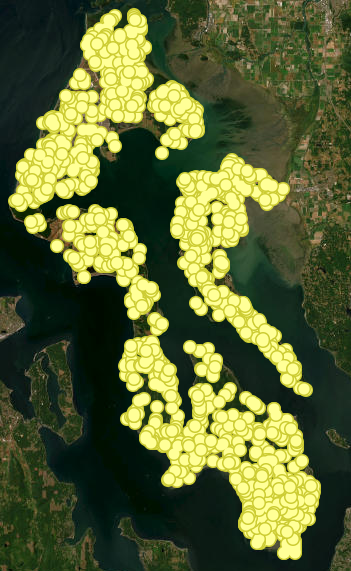
The image is carpeted with icons. For an interactive map click here. Barely any land is left to look at. Dots everywhere. That’s OK. Well water is ubiquitous. Many homes get water from community and municipal wells. Living there can feel no different than the piped water in Oak Harbor, it’s just that the pipe doesn’t have to run as far. One indication that something is different is a sign at the neighborhood’s border that announces whether the water supply is Normal or whether there’s rationing. Droughts happen.
Homeowners in more remote places can have an intimate awareness of their water supply because they have a well on their property. Nicer wells get to live in little houses and sheds that are usually far removed from the house, the septic system, and any other buildings. Here’s where there’s a possible mixing of the waters.
Naturally, rainwater falls, and either runs off the land or seeps through it. Rivers and streams are obvious runoff avenues, but sometimes the rainwater is just below the surface. It still flows, but in broad swathes, not as rivers or streams. Water also seeps deeper, flowing into and filling underground aquifers. It is those aquifers that wells drill into.
What are aquifers?
Aquifers are the unseen reservoirs and streams that collect and channel rainwater naturally. That isn’t just an island thing. Farms in the Great Plains drill into massive aquifers. Island aquifers are smaller. They are also a bit of a mystery. What kind of soil are they under and in? How big is it? How deep is it? How much water is in it? Is there more than one?
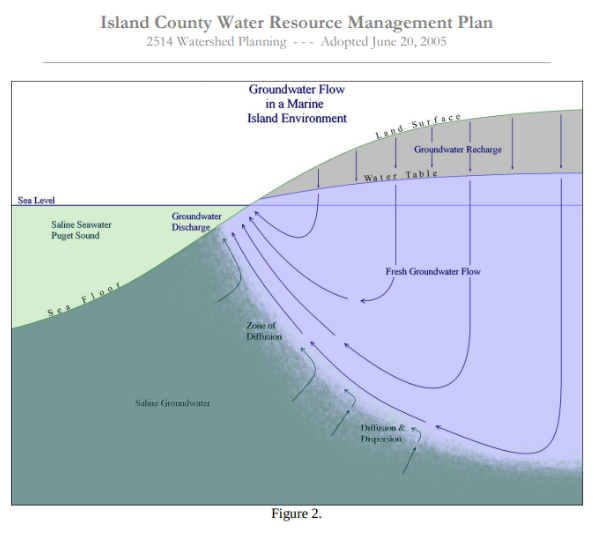
Hence, the drilling. For decades, residents who want to build on some land have had to check with the County about whether there is already a well, or maybe one they can try to share, or whether they’ll have to hire a well-digger – and hope.
Why all of this prelude and background?
Each aquifer has a limit to how much water can be drawn from it. It may seem obvious in retrospect, but pump out enough fresh water, and the surrounding saltwater can be drawn in, too. Voila or oops, a fresh water supply can run dry, or turning on a tap pours out salty water.
Saltwater coming up a freshwater well was less likely for the early settlers. It could happen if a well was drilled too close to the shore, especially if it was a shallow well. Seawater intrusion is no longer abstract. Look at a map of the island. Click here for an interactive map. A scattering of spots are marked as at risk of seawater intrusion. Some are already experiencing it.
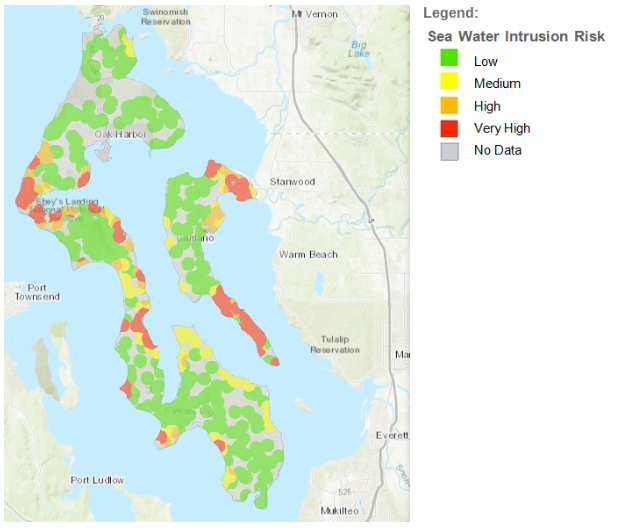
Considerations when purchasing land or a new home
Risk of seawater intrusion can be one reason a neighborhood has to curtail further development. Vacant land can look enticing, but if it can’t access water, then it probably can’t have a livable house built on it. The term ‘water shares’ comes up. So do fees for tapping into restricted supplies. Drilling another well won’t work because it could pull in more of the sea.
Whidbey’s highest point is about 500 feet above sea level. Some wells have drilled so deep that they are hundreds of feet below sea level. And yet, when done right, with the right aquifer, pumped at below a specified rate, there may be no problem. Enjoy your freshwater but, analyzing that map with your broker will help ensure you know where there are concerns and restrictions.
Are there other reasons the water tastes different?
Of course, seawater intrusion is not always the reason water tastes different. Well water is natural. Minerals in the ground are natural. Drinking from an underground aquifer can be flavored by the minerals the water has seeped through. Chefs, cooks, and foodies take note when using natural water and its natural flavorings. It might be an improvement or a reason to buy or get deliveries of filtered water. Some of the minerals and hardness of island water comes from these elements: Arsenic, Calcium, Chloride, Hardness, Iron, Potassium, Magnesium, Manganese, Nitrate, Phosphorus, Sodium, and Sulfate. Household systems can be installed to make the water better match your preferences. Some are as simple as a countertop pitcher with a filter. Others can be systems occupying separate sheds because they’re larger or noisier than an owner wants in the house. Ask your broker who they recommend calling for help.
Are you curious about what’s in your water?
Private and public organizations can test for various chemicals. Your sensitivities will influence your assessment of the water’s quality. Have you ever been encouraged to drink the water as a part of your home inspection? Or even when deciding to write an offer on a property? You should on Whidbey!
The good news is that we know a lot more now than we did before. Within the last few decades, the government has been able to better measure and assess the situation. Guesses are being replaced with answers. Technologies and techniques are being developed that ease the probability of sucking in seawater.
The other good news is that some common sense can make things easier. If the sign says the levels are low, adjust your usage until they recover. It rains here, you know. Trust the rain to water a lawn. Letting your lawn go golden during our dry spells is normal. (Bonus: Less mowing!) Rain catchment systems are gaining acceptance. At the most basic level, use less water. You can benefit, and so can your neighbors.
If you are curious about learning more, or are looking to buy and not currently represented by an agent and would like to work with an agent with extensive knowledge on aquifers and our island connect with us.

 Facebook
Facebook
 X
X
 Pinterest
Pinterest
 Copy Link
Copy Link
